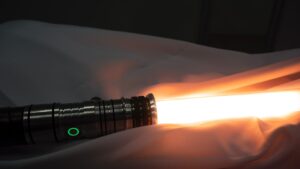Golden State is ticking all the right boxes for anyone looking for a monster scale lithium-gold play.

Golden State Mining’s focus is on its district scale Li-Au 730km2 Yule project, just 13km up the road from De Grey Mining’s world class Hemi gold discovery. Pic via Getty Images.
Golden State is ticking all the right boxes for anyone looking for a monster scale lithium-gold play.
How do you find those 10 bagger exploration stocks?
Usually they come from greenfields discoveries, like those unearthed by Chalice (ASX:CHN) or De Grey (ASX:DEG) in Western Australia.
Famed investor Rick Rule says to find these elephants, explorers often need a district scale land package.
“And more often than not you want it in mineralised terrain, but not a known camp,” he says.
“You look at what Robert Friedland’s Ivanhoe Mines did to discover the massive Kamoa-Kakula copper mine in DRC.
“He looked at the extension to the Katangan copper belt, but he looked for it under sand, where the Belgians couldn’t have found copper [historically] because they did not have the ability to RAB drill through 10 or 12 metres of cover.
“He made the most important copper discovery in the last 100 years. That’s the sort of thing you are looking for.”
Golden State Mining: A district scale greenfields lithium-gold play
Ticking all those boxes is WA explorer Golden State Mining (ASX:GSM) , which is hunting for tier 1 gold and lithium discoveries across three large scale greenfields projects: Yule, Paynes Find and Southern Cross.
Its main focus right now is Yule, a 730km2 project, 35km from Port Hedland and 13km from De Grey Mining’s world class Hemi gold discovery.
“From our perspective, while some people may have considered this area to be a bit of a risk from an exploration perspective, the discovery of Hemi more than justified our ambitions and reasons for picking up ground in that area,” Golden State managing director Mike Moore told Stockhead.
“At the time, we probably had 350km2 of ground there, but fortuitously just before the Hemi discovery we picked up another ~350km2.”
Like Friedland’s Katangan copper belt, Yule is under 15m-20m of cover which has hidden any discoveries from previous explorers.
That project now has +55,000m of systematic, mostly-aircore drilling into it, which has uncovered several exciting gold and lithium targets, the most advanced of which is a lithium prospect called ’Nomad’.
All the signs point to something significant at Nomad
Golden State has defined a +2km long, 800m wide bedrock lithium-caesium-rubidium anomaly at Nomad.
Overlaying that is a strong coherent arsenic anomaly, and limited RC drilling has also pulled up 6m @ 421ppm caesium from 103m.
You just don’t see these sorts of numbers unless there’s something going on, Moore says.
“You are basically adding the layers that you want to see,” he says. “The analogy that has been drawn is with Greenbushes [lithium mine] where there is, a pervasive arsenic anomaly on and around the deposit there.
“Meanwhile caesium is not a very mobile element, which means the source, ideally pegmatitic source, is close by.
“If there is a lithium pegmatite there, it’s got to be within a few 100 metres rather than kilometres.
“For us, it’s just about amping up that drilling, getting more holes in the ground, to better understand what we’ve got down there.”
That 2000m drilling program has been pencilled in for June, Moore says, adding “We’ve already identified the areas where we are going to be drilling.”
“The plan will probably be to do at least 2000m of RC drilling, and some complimentary air core as well,” he says. “We’re liaising with the rig owners to schedule in a date.”
Paynes Find: A new lithium province in the Murchison
The unexplored 1200km2 Paynes Find project in the Murchison region sits alongside known pegmatite occurrences at Mt Edon and Goodingnow.
Everest Metals (ASX:EMC) is currently drilling a bunch of lithium targets right next door at Mt Edon.
“Paynes Find was ground we pegged based on internal technical work and the use of consultants,” Moore says.
“We were looking for something where we could get a significant footprint, and perhaps somewhere where people had forgotten, or dismissed.
“We’ve done two soil sampling campaigns – one of which we have announced the results of.
“We’re just waiting on the results for that second soil campaign and then we can come up with target areas that we’d like to drill there.”
That drilling campaign has been pencilled in the second half of the year.
Southern Cross and Four Mile Well: Unexplored, large scale gold plays
The region surrounding GSM’s Southern Cross tenements is peppered with significant gold mines and deposits.
“Our area is very under-explored because, again, because there’s not a lot of outcrop there,” Moore says.
“But we believe that there’s a structure there that runs effectively north south. And, we felt that, given that there was several occurrences and mines to the north, perhaps there was Greenstone there.”
GSM have completed a first phase soil sampling program, with results imminent.
“Hopefully we will generate some targets out of that,” Moore says. “We may do some follow up work as the precursor to some drilling again, towards the back end of this year.”
Drill results are also pending from Four Mile Well near Laverton, where GSM has defined a coherent ~4km x ~4km arsenic-bismuth +/- gold anomaly over interpreted buried greenstones.
’A track record of putting holes in the ground’
GSM are aiming big. They want a tier 1 discovery like Hemi, Pilgangoora or Greenbushes, and they have all the ingredients in place for success.
“And that’s why we picked up strong regional scale ground positions in areas that could have good underlying geological fundamentals,” Moores says.
“We’ve also got a demonstrated track record of putting holes in the ground.
“As I’ve always said, if a company you’ve invested in isn’t putting drill holes in the ground, you haven’t got a chance of discovery.
“We’ve got a very tight capital structure and a strong management and technical team that’s guiding that work.
“And you know, we’ve been well supported by the brokers. There’s faith in terms of what we’re doing, and the technical arguments that we’re prosecuting.”
This article was developed in collaboration with Golden State Mining, a Stockhead advertiser at the time of publishing.
This article does not constitute financial product advice. You should consider obtaining independent advice before making any financial decisions.
Related Topics

UNLOCK INSIGHTS
Discover the untold stories of emerging ASX stocks.
Daily news and expert analysis, it's free to subscribe.
By proceeding, you confirm you understand that we handle personal information in accordance with our Privacy Policy.








